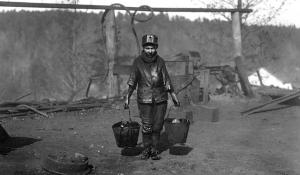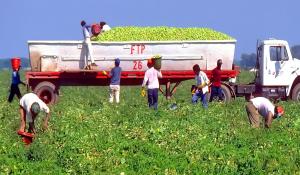
Q. What are sweatshops and how bad is the problem?
A. The US Department of Labor defines a sweatshop as any factory that violates two or more labor laws, such as those pertaining to wages and benefits, working hours, and child labor. Anti-sweatshop advocates go further to say that beyond following the letter of the law (which can be very weak in many countries that attract sweatshops), a factory must pay a living wage in safe working conditions, enforce reasonable work hours, provide for sick leave and maternity leave, and allow workers to organize to avoid being labeled a sweatshop.
Because no single definition exists (and because sweatshop owners don't want their factories to be revealed), it’s difficult to assess the worldwide scope of the problem. Compounding this difficulty is the “race to the bottom,” which means that companies don’t always let their sweatshop factories stay in one place, if they can shift their manufacturing to ever-cheaper and less-regulated locations. For example, the number of sweatshops in Mexico soared in the 1990s after NAFTA enticed companies to close their US operations and move south. As global manufacturing costs continued to shift, many companies then moved their operations from Mexico to even more attractive Asian countries. And more recently still, after the US-Jordan Free Trade agreement went into effect in 2000, the number of sweatshops in that country exploded as well. Between 2000 and 2005, apparel exports from Jordan to the US soared 2000 percent, often due to the round-the-clock labor of guest workers from poor Asian countries who were following the jobs as they moved.
Q: But if companies have to cut costs to stay competitive, aren’t sweatshops inevitable?
A: No. Low prices are only one of many factors consumers take into account when they shop, and most consumers don’t intentionally purchase goods made in sweatshops.
Reporting for Dollars and Sense magazine in 2006, sweatshop expert John Miller, a professor of economics at Wheaton College, explained how paying decent wages to workers at the beginning of the supply chain has little effect on a company’s competitiveness. “In Mexico’s apparel industry, economists from the Political Economy Research Institute found that doubling the pay of non-supervisory workers would add just $1.80 to the cost of a $100 men’s sports jacket,” explained Miller. “And a recent survey by the National Bureau of Economic Research Found that US consumers would be willing to pay $115 for the same jacket if they knew it had not been made under sweatshop conditions.”
Living wages and reasonable working hours would not threaten companies’ overall profitability. No one should have to work 17-hour days just so Americans can save a few dollars on clothes.
Q: Doesn’t low-wage sweatshop employment help alleviate poverty? Aren’t sweatshops a necessary step on the road to economic development?
A: No. Sweatshop workers are trapped in a cycle of exploitation that rarely improves their economic situation.
“In many cases, countries’ minimum wages are insufficient to climb out of poverty,” says Todd Larsen, Green America’s Executive Co-Director for Consumer & Corporate Engagement. “What’s more, sweatshop watchdog groups continually find factories that pay illegal wages, lower even than the minimum.”
Consider the example cited in a 2003 National Labor Committee report on a Honduran worker sewing clothing for Wal-Mart at a rate of 43 cents an hour. After spending money on daily meals and transportation to work, the average worker is left with around 80 cents per day for rent, bills, child care, school costs, medicines, emergencies, and other expenses.
If sweatshops were a necessary step toward economic development, they would not exist in the world’s most developed economies; however, sweatshops continue to be uncovered even in the United States. The US Department of Labor regularly uncovers sweatshop abuse in American factories, which are often contracted to make fast fashion clothing for American brands.
Q: Isn’t it time-consuming and expensive for corporations to track their goods’ origins?
A: No, most corporations already track their goods to the subcontractor or factory level in order to monitor the quality of their products.
“In competitive industries like the apparel industry, all companies have quality control,” says Nikki Bas, executive director of Partnership for Working Families. “If companies are able to send representatives to inspect the quality of a garment, they can inspect the quality of their factories as well.”
Q: Do some companies track their goods to keep sweatshop labor out of their supply chains, and mark their products with a special label?
A: Unfortunately, no overarching “sweatshop-free” label exists, though a union label is a good indicator that at a minimum workers are free to organize and have a voice. In addition, since the mid-1990s, a number of “social auditing” organizations have emerged, and companies may now coordinate with one to inspect their factories for sweatshop abuses, to greater or lesser degrees of success.
These organizations operate under a number of different structures. For example, Verité, operates as a nonprofit organization, inspecting factories on behalf of their client companies, which pay Verité a fee to perform audits and help facilitate follow-up correction programs for violations. (Verité does not make its findings public because conditions can change so quickly in faraway factories.)
Another example, Worldwide Responsible Apparel Production (WRAP), operates as a 501(c)6 corporation, and makes its list of inspected and certified factories available on its website, searchable by country, as a resource for companies in search of factories. Established by the American Apparel and Footwear Association, WRAP has come under fire from anti-sweatshop organizations as having weak codes of conduct and operating too closely with the apparel industry.
Similarly, the Fair Labor Association, which contracts with specific companies to perform inspections, has fallen out of favor with many activists over concerns about poor enforcement and corporate influence.
Whichever monitoring organization a company might use (and there are many more), the bottom-line concern among anti-sweatshop activists lies in the lack of transparency to the consumer of the findings, as well as the inability of inspectors to stay aware of factory conditions at all times. Instances of factories improving their conditions specifically for inspections are well-documented, and critics further charge that monitoring organizations lengthen the supply chain, relieving companies of their responsibility to vouch personally for the conditions of their factories.
Q. If something is made in the USA does that automatically mean it is sweatshop-free?
A: Unfortunately, just because something is Made In The USA doesn't mean it isn't made in a sweatshop. In general, countries with strong labor laws (not just the US, but several European countries, Cambodia, and others) may produce fewer sweatshop abuses than countries with weaker or non-existent laws, but no one country is automatically sweatshop-free.
For instance, the Department of Labor conducted random inspections on 77 garment factories in southern California in November 2016, and discovered that 85% of the inspected factories were violating federal labor laws. Major retailers including Forever 21, Ross, and T.J. Maxx, contracted these factories to create bargain-price clothing, at the expense of the industry's primarily immigrant workforce.
Grievous sweatshop abuses have not only been uncovered in U.S. factories, but also in factories located in U.S. territories. These factories may also use the "Made in the USA" label, despite being exempt from certain U.S. labor laws.
For example, for many years garment workers in Saipan, in the Commonwealth of the Northern Marianas Islands (CNMI) have been exploited under the islands’ exemption to US labor laws. Efforts to bring CNMI under US law have long been stymied by lobbyists and lawmakers sympathetic with exploitative garment businessess, though as this guide was going to press, the US Senate voted to finally extend federal labor and immigration laws to CNMI.
Q. How do I learn more?
There may be common items or foods you did not know were made with working conditions that endanger people and the planet. Here are eight things made with sweatshop labor. Green America is working to end sweatshop labor. Join us! Here are steps you can take to end sweatshop labor.






